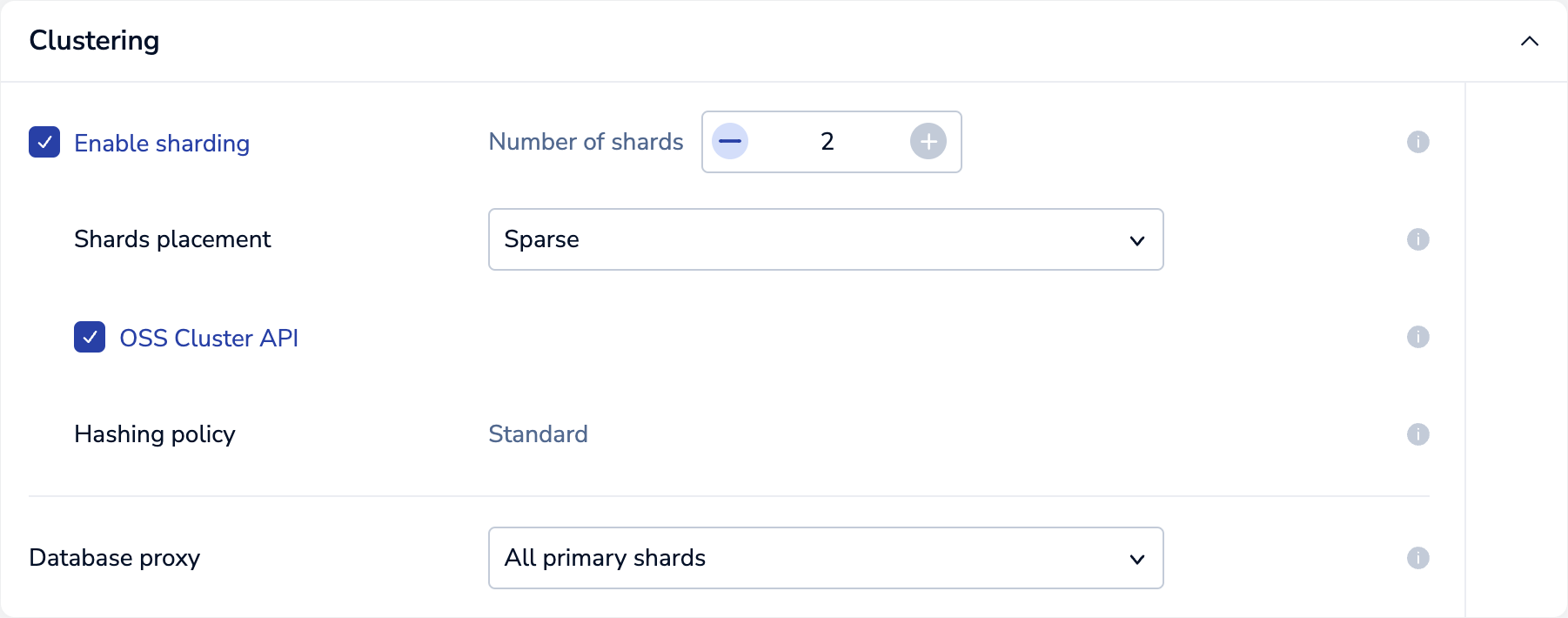Enable OSS Cluster API
| Redis Enterprise Software |
|---|
Review Redis OSS Cluster API to determine if you should enable this feature for your database.
Prerequisites
The Redis OSS Cluster API is supported only when a database meets specific criteria.
The database must:
- Use the standard hashing policy.
- Have the proxy policy set to either All primary shards or All nodes.
In addition, the database must not:
- Use node
includeorexcludein the proxy policy. - Use RedisTimeSeries or RedisGears modules.
The OSS Cluster API setting applies to individual databases instead of the entire cluster.
Enable OSS Cluster API support
You can use the Cluster Manager UI, the rladmin utility, or the REST API to enable OSS Cluster API support for a database.
When you enable OSS Cluster API support for an existing database, the change applies to new connections but does not affect existing connections. Clients must close existing connections and reconnect to apply the change.
Cluster Manager UI method
When you use the Cluster Manager UI to enable the OSS Cluster API, it automatically configures the prerequisites.
To enable the OSS Cluster API for an existing database in the Cluster Manager UI:
-
From the database's Configuration tab, select Edit.
-
Expand the Clustering section.
-
Select Enable sharding.
-
Select OSS Cluster API.

-
Select Save.
You can also use the Cluster Manager UI to enable the setting when creating a new database.
Command-line method
You can use the rladmin utility to enable the OSS Cluster API for Redis Enterprise Software databases, including Replica Of databases.
For Active-Active (CRDB) databases, use the crdb-cli utility.
Ensure the prerequisites have been configured. Then, enable the OSS Cluster API for a Redis database from the command line:
$ rladmin tune db <database name or ID> oss_cluster enabled
To determine the current setting for a database from the command line, use rladmin info db to return the value of the oss_cluster setting.
$ rladmin info db test | grep oss_cluster:
oss_cluster: enabled
The OSS Cluster API setting applies to the specified database only; it does not apply to the cluster.
REST API method
You can enable the OSS Cluster API when you create a database using the REST API:
POST /v1/bdbs
{
"oss_cluster": true,
// Other database configuration parameters
}
To enable the OSS Cluster API for an existing database, you can use an update database configuration REST API request:
PUT /v1/bdbs/<database-id>
{ "oss_cluster": true }
Active-Active databases
The OSS Cluster API setting applies to all instances of the Active-Active database across participating clusters. To enable the OSS Cluster API for Active-Active databases, use the Cluster Manager UI or the crdb-cli utility.
To create an Active-Active database and enable the OSS Cluster API with crdb-cli:
$ crdb-cli crdb create --name <name> \
--memory-size 10g --port <port> \
--sharding true --shards-count 2 \
--replication true --oss-cluster true --proxy-policy all-master-shards \
--instance fqdn=<fqdn>,username=<user>,password=<pass> \
--instance fqdn=<fqdn>,username=<user>,password=<pass> \
--instance fqdn=<fqdn>,username=<user>,password=<pass>
See the crdb-cli crdb create reference for more options.
To enable the OSS Cluster API for an existing Active-Active database with crdb-cli:
-
Obtain the
CRDB-GUIDfor the new database:$ crdb-cli crdb list CRDB-GUID NAME REPL-ID CLUSTER-FQDN <CRDB-GUID> Test 4 cluster1.local -
Use the
CRDB-GUIDto enable the OSS Cluster API:$ crdb-cli crdb update --crdb-guid <CRDB-GUID> \ --oss-cluster true
Change preferred IP type
By default, using CLUSTER SLOTS and CLUSTER SHARDS in a Redis Enterprise Software cluster exposes the internal IP addresses for databases with the OSS Cluster API enabled.
To use external IP addresses instead of internal IP addresses, run the following rladmin tune db command for each affected database:
$ rladmin tune db db:<database-id> oss_cluster_api_preferred_ip_type external
Turn off OSS Cluster API support
To deactivate OSS Cluster API support for a database, either:
-
Use the Cluster Manager UI to turn off the OSS Cluster API in the Clustering section of the database Configuration settings.
-
Use the appropriate utility to deactivate the OSS Cluster API setting.
For standard databases, including Replica Of, use
rladmin:$ rladmin tune db <name or ID> oss_cluster disabledFor Active-Active databases, use the Cluster Manager UI or
crdb-cli:$ crdb-cli crdb update --crdb-guid <CRDB-GUID> \ --oss-cluster false
When you turn off OSS Cluster API support for an existing database, the change applies to new connections but does not affect existing connections. Clients must close existing connections and reconnect to apply the change.
Multi-key command support
When you enable the OSS Cluster API for a database, multi-key commands are only allowed when all keys are mapped to the same slot.
To verify that your database meets this requirement, make sure that the CLUSTER KEYSLOT reply is the same for all keys affected by the multi-key command. To learn more, see multi-key operations.